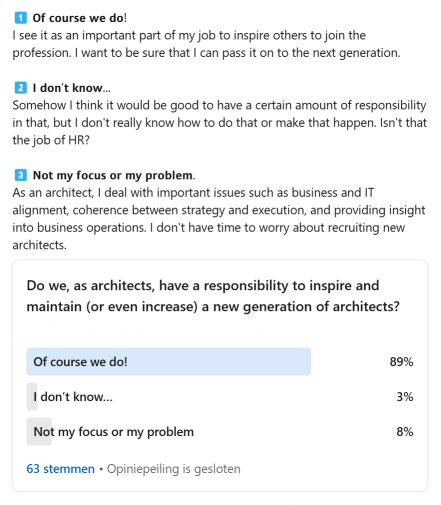When we think of Enterprise Architecture, we often imagine dynamic teams designing robust frameworks to steer organizations into the future. But a quieter challenge looms: the profession itself is aging, and a younger generation is not stepping in to take the reins. This trend, often referred to as the graying of architecture, threatens to disrupt the future of the field.
Why is this happening?
Why is Enterprise Architecture graying? The profession, which demands deep experience and a broad understanding of business, technology, and organizational dynamics, has always attracted seasoned professionals. But as these architects age out, a gap emerges. Here’s why:
- A pipeline problem. Few young professionals are being groomed to enter the field. Architecture is not a common career aspiration, and the path to becoming an Enterprise Architect isn’t clearly defined in academia or early career stages.
- Misunderstandings about the role. Enterprise Architecture is often mistaken for IT Architecture, limiting its appeal to those who might excel in broader organizational strategy.
- Cultural shifts. New generations entering the workforce value flexibility and creativity, while architecture can appear rigid or overly technical to the uninitiated.
When did we not pay attention?
To understand the scope of the issue, we need to look at the evolution of Enterprise Architecture. The field gained prominence in the late 20th century, with frameworks like the TOGAF® Standard emerging to provide structure and consistency. Those who pioneered these frameworks are now nearing retirement. Yet, organizations continue to rely on their expertise to navigate increasingly complex challenges.
Architecture frameworks need to adapt to the needs of the next generation of architects. This new generation of professionals is looking for ways to understand the profession. They need to be educated on how to apply and practice architecture, rather than overloading them with the theoretical approach we’ve been advocating for the past few decades. It is high time that we as architects learn to adapt to the new rising standards of knowledge acquisition.
Consider this: a profession built on adaptation and forward-thinking is itself failing to evolve its talent base. It’s a paradox that demands urgent attention.
What does this imply?
What does this mean for organizations? For one, without new architects to learn from the outgoing generation, valuable institutional knowledge is lost.
Younger professionals often bring fresh perspectives, which are crucial for addressing new challenges like digital transformation and sustainability.
Architecture underpins long-term strategy, and without continuity, organizations risk stagnation and missed opportunities.
How do we fix this?
The solution lies in addressing this issue head-on. But how?
- Redefine the role. Enterprise Architects are not just technologists—they’re strategists, communicators, and innovators. Highlighting these aspects can make the profession more appealing to a broader range of talents.
- Engage early. Few universities offer programs focused on Enterprise Architecture1. By collaborating with academic institutions, organizations can create awareness and spark interest in students before they enter the workforce. Coupled with practical guidance and existing literature on a more pragmatic approach, this will help gain (and retain) student interest.
- Mentorship programs. Encouraging senior architects to mentor young professionals ensures knowledge transfer and helps demystify the field. Formal mentorship programs can be a game-changer in bridging the generational gap.
- Certifications and training. Today’s certifications are aimed at the more seasoned professionals. Organizations like The Open Group, which oversees the TOGAF framework, could emphasize training programs tailored to early-career professionals. A clear certification path provides both motivation and direction. Creating educational programs for students—again, from a more practical and pragmatic perspective—will undoubtedly be a step in the right direction.
- Adapt to modern workstyles. To attract younger talent, the profession must align with modern values. This means fostering creativity, emphasizing work-life balance, and showcasing how Enterprise Architects contribute to meaningful organizational change. Emphasizing the business value of Enterprise Architecture once again proves essential.
We need to take action

This challenge is daunting but solvable. Enterprise Architecture is, at its core, about creating order and value in complex environments. Applying these principles to the profession itself is not only possible—it’s essential.
Near the end of 2024, I ran a poll on LinkedIn asking if we, as architects, have a responsibility to inspire and sustain (or even grow) a new generation of architects. The results are shown in the image. Fortunately, most of the respondents agreed that something needs to be done and that we are the ones to do it.
Imagine a future where Enterprise Architecture thrives with diversity in age, perspective, and skill. Younger professionals, armed with cutting-edge tools and guided by experienced mentors, could lead organizations into an era of unprecedented innovation.
Conclusion
The graying of architecture is a wake-up call for the profession. If ignored, it risks obsolescence. But if addressed, it opens the door to a renaissance, with new generations building on the legacy of their predecessors.
The question is not whether Enterprise Architecture can adapt—it’s whether we’re ready to steer it into the future. Let’s not just imagine a better tomorrow for the profession. Let’s architect it.
- The Laval University in Canada does have a course on Enterprise Architecture. They also use my book Getting Started with Enterprise Architecture as study material. ↩︎







Leave a Reply